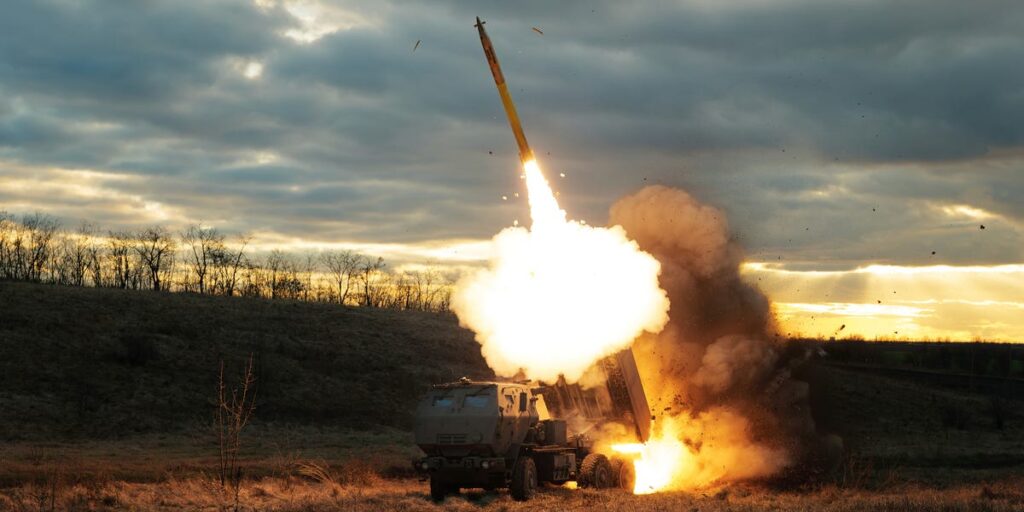The Biden administration’s policy restricting Ukraine from using US-provided weapons to strike military targets inside Russia is hamstringing Kyiv’s ability to defend itself, analysts and officials say.
The US has sent Ukraine billions of dollars in security assistance over the course of the war, but it has barred the country from using American weaponry, especially certain powerful long-range missiles, to carry out strikes across the border.
Washington has been unwavering in its stance on this matter, instead giving Kyiv approval to only hit targets within Russian-occupied territory in Ukraine.
But the Biden administration is facing increasing pressure to soften this long-held policy in the wake of a new Russian assault in Ukraine’s northeastern Kharkiv region, which began earlier this month. Analysts and officials have argued in the days since that the US position has prevented Kyiv from stopping the onslaught, effectively hamstringing its defensive capabilities.
‘Handcuffing’ the Ukrainian defense
After massing tens of thousands of troops near the border, Russia on May 10 launched an assault into the Kharkiv region as part of a bid to stretch thin Ukrainian forces across the front line and pin down Kyiv’s defenses in the region, and also carve out a buffer zone along the border.
The limited incursion appears to be setting the stage for what could be a multi-pronged summer offensive that would stress a Ukrainian military still facing shortages in both material and much-needed manpower.
Immediately after the initial assault, analysts and officials pointed to the Biden administration’s policy preventing Ukraine from using US weapons to strike military targets inside Russia as the catalyst for the unfolding situation, in which Moscow has already managed to capture a small amount of territory along the border.
George Barros, the geospatial-intelligence team lead and a Russia analyst at the Institute for the Study of War think tank, said last week that the restriction is “severely compromising Ukraine’s ability to defend itself” against the assault.
“US policy has effectively created a vast sanctuary in which Russia has been able to amass its ground invasion force and from which it is launching glide bombs and other long-range strike systems in support of its renewed invasion,” Barros wrote in a May 13 analysis.
Glide bombs, in particular, have been a significant threat to Ukrainian forces. Really the only way to defend front-line forces and civilians from these highly destructive weapons is to intercept the Russian aircraft before they can launch the munitions, or attempt to take them out on the ground. But these aircraft are operating within the safety of their own airspace, out of reach of air-defense systems.
“Whatever the merits of this US policy before the Russian assault on Kharkiv Oblast began, it should be modified immediately to reflect the urgent realities of the current situation,” Barros said.
Ukrainian officials told POLITICO last week that the country watched as Russian forces gathered across the border, but they could not do anything to blunt the assault because of the US policy. The officials had traveled to Washington as part of a new push from Kyiv to try and get the Biden administration to lift its ban.
After meeting with the delegation of Ukrainian officials, a group of Congressional lawmakers on Monday wrote to US Defense Secretary Lloyd Austin, urging the Biden administration to lift its restrictions and provide Kyiv with additional defensive capabilities that it badly needs.
In the bipartisan letter, more than a dozen lawmakers cited the POLITICO report, saying that the administration’s current policy “is handcuffing Ukraine’s ability to push back on Russian forces near Kharkiv” with US-provided weaponry. “Ukrainian officials have watched for weeks as Russian troops have attacked Ukrainian communities from Russian territory with impunity,” they wrote.
“Ukrainians have been unable to defend themselves due to the Administration’s current policy,” the lawmakers continued. “It is essential the Biden Administration allows Ukraine’s military leaders an ability to conduct a full spectrum of operations necessary to respond to Russia’s unprovoked attack on their sovereign land.”
Indeed, Ukrainian soldiers have highlighted this challenge in recent discussions with Western media.
“There were a lot of Russians gathering, and we could have destroyed them on the way in, but we don’t have many ATACMS, and we have a ban on using them over there,” a Ukrainian special forces commander who watched as Russia built up its forces on the Russian side of the border told The Times of London, referring to the US-provided MGM-140 Army Tactical Missile Systems. He told the outlet that having to wait for the enemy to cross into Ukrainian territory proved costly.
The US has long feared that a change in its policy could be seen by Russian President Vladimir Putin as an escalation. Washington has also held this attitude when considering whether to send high-profile weaponry to Ukraine.
Former Under Secretary of State for Political Affairs Victoria Nuland pushed back on this rationale during a Sunday interview on ABC News’ “This Week.” She said Russia has already taken steps to escalate the conflict, including by conducting its recent assault on Kharkiv, and argued that it’s now time for the US to change its policy.
Bases in Russian territory that are facilitating Moscow’s attacks should be “fair game” for Ukraine to go after, she said. “Russia has learned how to pull its forces back out of the range where we have allowed Ukraine to use our weapons and get our support.”
Despite mounting support for the US to lift its ban, and the surprising loosening of similar restrictions by the UK government earlier this month, Washington seems unlikely to alter its position anytime soon.
“Our policy hasn’t changed,” Pentagon Press Secretary Air Force Maj. Gen. Pat Ryder told reporters at a Tuesday press briefing. “We are focused on providing Ukraine with capabilities that it needs to defend itself within Ukrainian sovereign territory.”
Ukraine, meanwhile, has been forced to find innovative and alternative solutions to carry out long-range cross-border strikes. In lieu of Western missiles, for instance, Kyiv has relied heavily on homemade drones packed with explosives to attack strategic military and energy facilities hundreds of miles deep inside Russian territory.
Read the full article here
















